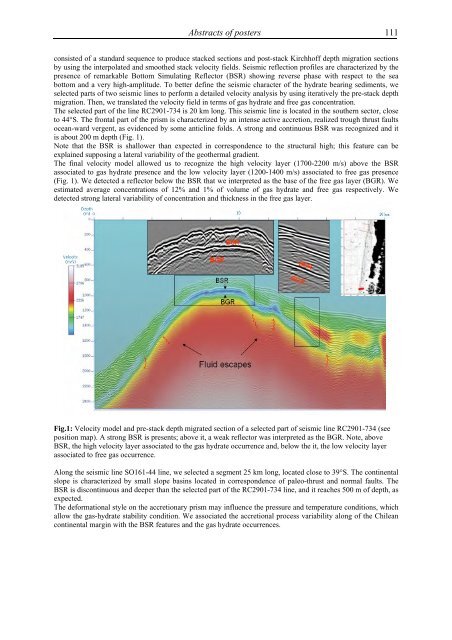Ninth international conference on - Marum
Ninth international conference on - Marum
Ninth international conference on - Marum
You also want an ePaper? Increase the reach of your titles
YUMPU automatically turns print PDFs into web optimized ePapers that Google loves.
Abstracts of posters 111<br />
c<strong>on</strong>sisted of a standard sequence to produce stacked secti<strong>on</strong>s and post-stack Kirchhoff depth migrati<strong>on</strong> secti<strong>on</strong>s<br />
by using the interpolated and smoothed stack velocity fields. Seismic reflecti<strong>on</strong> profiles are characterized by the<br />
presence of remarkable Bottom Simulating Reflector (BSR) showing reverse phase with respect to the sea<br />
bottom and a very high-amplitude. To better define the seismic character of the hydrate bearing sediments, we<br />
selected parts of two seismic lines to perform a detailed velocity analysis by using iteratively the pre-stack depth<br />
migrati<strong>on</strong>. Then, we translated the velocity field in terms of gas hydrate and free gas c<strong>on</strong>centrati<strong>on</strong>.<br />
The selected part of the line RC2901-734 is 20 km l<strong>on</strong>g. This seismic line is located in the southern sector, close<br />
to 44°S. The fr<strong>on</strong>tal part of the prism is characterized by an intense active accreti<strong>on</strong>, realized trough thrust faults<br />
ocean-ward vergent, as evidenced by some anticline folds. A str<strong>on</strong>g and c<strong>on</strong>tinuous BSR was recognized and it<br />
is about 200 m depth (Fig. 1).<br />
Note that the BSR is shallower than expected in corresp<strong>on</strong>dence to the structural high; this feature can be<br />
explained supposing a lateral variability of the geothermal gradient.<br />
The final velocity model allowed us to recognize the high velocity layer (1700-2200 m/s) above the BSR<br />
associated to gas hydrate presence and the low velocity layer (1200-1400 m/s) associated to free gas presence<br />
(Fig. 1). We detected a reflector below the BSR that we interpreted as the base of the free gas layer (BGR). We<br />
estimated average c<strong>on</strong>centrati<strong>on</strong>s of 12% and 1% of volume of gas hydrate and free gas respectively. We<br />
detected str<strong>on</strong>g lateral variability of c<strong>on</strong>centrati<strong>on</strong> and thickness in the free gas layer.<br />
Fig.1: Velocity model and pre-stack depth migrated secti<strong>on</strong> of a selected part of seismic line RC2901-734 (see<br />
positi<strong>on</strong> map). A str<strong>on</strong>g BSR is presents; above it, a weak reflector was interpreted as the BGR. Note, above<br />
BSR, the high velocity layer associated to the gas hydrate occurrence and, below the it, the low velocity layer<br />
associated to free gas occurrence.<br />
Al<strong>on</strong>g the seismic line SO161-44 line, we selected a segment 25 km l<strong>on</strong>g, located close to 39°S. The c<strong>on</strong>tinental<br />
slope is characterized by small slope basins located in corresp<strong>on</strong>dence of paleo-thrust and normal faults. The<br />
BSR is disc<strong>on</strong>tinuous and deeper than the selected part of the RC2901-734 line, and it reaches 500 m of depth, as<br />
expected.<br />
The deformati<strong>on</strong>al style <strong>on</strong> the accreti<strong>on</strong>ary prism may influence the pressure and temperature c<strong>on</strong>diti<strong>on</strong>s, which<br />
allow the gas-hydrate stability c<strong>on</strong>diti<strong>on</strong>. We associated the accreti<strong>on</strong>al process variability al<strong>on</strong>g of the Chilean<br />
c<strong>on</strong>tinental margin with the BSR features and the gas hydrate occurrences.














